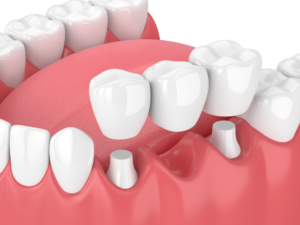Preparing for a Dental Crown: Insights from an Edgebrook Dentist

When preparing a tooth for a dental crown, you will typically need to have two visits with your Edgebrook dentist. The first step will involve the examination and preparation of the tooth, while the second visit will involve the placement of the permanent crown.
First Visit: Examining and Preparing the Tooth
During the first visit to prepare the dental crown, the dentist may take several x-rays to check the roots of the tooth that will receive the crown, as well as the surrounding bone. If the tooth has suffered extensive decay, or if there is a risk of injury or infection of the pulp of the tooth, a root canal may need to be performed first. This will require a few additional visits to the dentist.
Before starting to place your crown, the dentist will anesthetize or numb the tooth and the gum tissue surrounding the tooth. Next, the doctor will file down the tooth along the chewing surface and sides to create room for the crown.
The type of crown will dictate the amount that needs to be removed. For instance, all-metal crowns are thinner, and therefore require less removal of the tooth structure than their all-porcelain or porcelain-fused-to-metal counterparts. On the other hand, if a large area of the tooth is missing due to damage or decay, the dentist may build up the tooth using filling material to provide the crown with support.
Once they have reshaped your tooth, the dentist will use putty or paste to make an impression of the tooth that will receive the crown. They will also make impressions of the teeth above and below the crown in order to ensure that the crown does not affect your bite. They will then send the impressions to the dental lab where the crown will be manufactured. The crown will typically be sent back to the dentist’s office within 2-3 weeks.
When the crown is made of porcelain, the dentist may also choose the shade that best matches the color of the adjacent teeth. During this visit, the dentist will make a temporary crown constructed out of acrylic to protect and cover the prepared tooth while the crown is being made.
Second Visit: Receiving the Permanent Dental Crown
On the second visit, the dentist will remove the temporary crown and evaluate the color and shape of the permanent crown. If everything is acceptable, they may use a local anesthetic to numb the tooth before attaching the new crown permanently in place.
Because temporary dental crowns are designed to provide a temporary fix until your permanent crown is ready, it is important to observe certain precautions. It’s recommended that you avoid sticky or chewy foods, such as caramel or chewing gum, which tend to grab or pull the crown off. You should also try to avoid chewing on the side of your mouth that has the temporary crown.
Types of Dental Crowns
These are some of the most often used types of dental crowns:
- Porcelain fused to metal crowns – Look like your natural teeth, but they tend to wear down over time.
- Gold crowns – They offer increased durability, but they stand out aesthetically.
- Zirconium crowns – the ideal choice for front teeth.
- Procera crowns – Metal-free, look like your natural teeth, and are growing in popularity.
- All resin crowns – More affordable than zirconium, and another good choice for front teeth.
Contact an Edgebrook Dentist Today
If you are looking for dental crowns in Edgebrook, Dr. Ziols and the team at Smile Innovations are here to help. Contact us today to schedule an initial appointment and further discuss your options.

